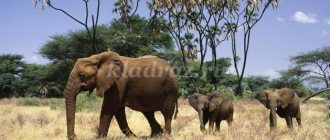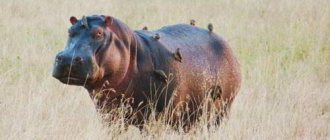South America is home to a huge number of animals and plants. On the mainland you can find both glaciers and deserts. Different natural and climatic zones contribute to the placement of hundreds of thousands of species of flora and fauna. Due to the variety of weather conditions, the list of animals is also very extensive and impressive with their unique features. Thus, representatives of mammals, birds, fish, insects, amphibians and reptiles live in South America. The continent is considered one of the most important on the planet. The Andes mountain range is located here, preventing the penetration of westerly winds, increasing humidity and contributing to large amounts of precipitation.
Elephants
What if the elephant was a predator?! Then it would be difficult for many, because they are capable of killing with just their weight. But they are not predators, and on top of that they are very kind. Here's what else is interesting about them:
- For two whole years, females carry their cubs, one can only hope that all this time they, as humans, are not tormented by terrible toxicosis.
- Elephant calves at birth do not have teeth, like human cubs, they first develop milk teeth, and only then molars.
- 300 liters and 300 kilograms : only elephants can eat and drink so much in one knock.
- Matriarchy reigns in elephant herds; mature and strong females become leaders.
- Each individual elephant has its own unique ear rim.
- Elephants cannot run at all; their fastest movement is fast walking.
- They eat not only grass and leaves, berries, fruits and even tree bark - this is a real delicacy for them.
- There are animals that weigh 6 kilograms, and there is the brain of an elephant, which weighs exactly the same. By the way, this affects their mental characteristics, because they are one of the most intelligent animals.
The animal world is very amazing, sometimes facts about them can delight you, and sometimes even frighten you. Our smaller brothers will surprise us more than once with newly revealed discoveries. In the meantime, here are some more amazing facts about animals from swelteringly hot countries:
- The lion remains king exclusively within hot climates; in cold climates, he is defeated by another king - the polar bear.
- Ostriches can safely be called single fathers; they mate with several females at the same time, and subsequently they lay their eggs in one nest and leave them in the care of their father.
- Male monkeys are going bald.
- In addition to tasty food, crocodiles also swallow stones, this helps them dive deep.
- If gorillas are fed birth control pills, they will also not become pregnant during mating.
- Elephants can draw.
- One monkey received a medal and a military rank during the First World War, maybe they really are so similar to people?
Crocodile
A crocodile lies in warm water in the very sun, warming itself. He closed his toothy mouth and did not move his combed tail. It’s like it’s just a rotten snag lying in the water, and not a living animal.
A crocodile lies in the water near the shore, waiting for prey. When a zebra or antelope comes to the river to drink water, he will hit the animal with his strong tail, knock him off his feet, grab him with his toothy mouth and drag him into the water, to the bottom.
River Rabbit
Current population: fewer than 250 breeding pairs and declining.
“Looks like you’d make a good stew,” says a farm worker as he catches a river rabbit with a gin trap. This rabbit is one of the most endangered land mammals in South Africa.
Their natural habitat is being destroyed with the removal of natural vegetation along rivers and streams, causing their numbers to decline.
The rabbit can be identified by the characteristic black stripe running from the corner of the mouth along the cheeks and white rings around the eyes.
Lions
The kings of beasts contain a lot of interesting things, namely:
- Despite their courage and bravery, of all predators they have the smallest heart.
- they sleep 20 hours a day .
- The muzzle of these predators is unique; you cannot find two lions whose muzzle will be completely the same, although people do not always notice this.
- They may look like formidable creatures, but in the circle of their pride they behave very affectionately, they love to rub their faces against each other.
- Lions can begin to roar only after two years; before this time they simply do not know how to do it.
- Lionesses feed not only their cubs with their mother's milk, but also all others in the pride.
- Taking food from other predators is not the style of lions; they are disdainful of eating what jackals and hyenas have touched.
- They don’t hunt just for fun, so even zebras can sleep peacefully next to a hungry lion.
Walrus
The walrus is fat and heavy. Like a huge leather bag of fat.
Two huge white fangs protrude from his bristly mustache. Instead of legs, the walrus has flippers. He uses them, like oars, to rake water.
It will dive deep under the water and graze on the bottom of the sea, like a cow in a meadow. He chews algae, looks for shells, and when he has eaten enough, he swims up, leans on the edge of the ice floe or on the shore with his fangs, pulls himself up and crawls out of the water. He lies down on the stones and rests.
Whale
The whale is the biggest animal in the world. He lives in the sea, swims in the water like a fish.
A whale will swim into the cold seas, where there is only ice and snow, and it will also swim to the south, where it is hot all year round, chasing schools of fish. Where the fish go, there he goes.
A whale will capture a whole school of fish along with water in its mouth, release the water, and the fish in its mouth will remain stuck in the whalebone. Just don't think that this is really a mustache. There are these plates in the whale's mouth, like a lattice, and these lattice is called whalebone.
Chimpanzee
About 150,000 chimpanzees remain in the wild.
Regionally extinct: Gambia, Benin, Burkina Faso and Togo.
Chimpanzees are found in the jungles of the Congo. The chimpanzee's diet consists mainly of fruits and plants, with insects, eggs and meat making up a small portion. Chimpanzees have the ability to communicate using facial expressions, sounds and gestures.
Studies conducted by scientists show that 95%-98% of the DNA of humans and chimpanzees are similar. Despite the fact that chimpanzees are considered the species closest to humans, they are still hunted. Chimpanzees have become endangered due to poaching, habitat destruction and the illegal pet trade.
Rainforest Canopy Dwellers
A tropical canopy is otherwise called a canopy. It is composed of tall, broad-leaved trees. Their crowns form a kind of roof over the litter and undergrowth. The height of the canopy is 35-40 meters. Many birds and arthropods hide in the treetops. There are 20 million species of the latter in the tropical canopy. There are fewer reptiles, invertebrates and mammals at altitude.
Kinkajou
Represents the raccoon family. Kinkajou lives in America. In the tropics, the animal settles in the crowns of trees. The kinkajou moves along their branches, clinging to its long tail. Despite the slight similarity and lack of relationship with clubfoot, the animals are called tree bears. It's about diet. Kinkajou loves honey. The animal obtains it using its tongue. It reaches 13 centimeters in length, allowing it to lick into the hive.
Kinkajous are easily tamed, very friendly and are often kept at home.
Malayan bear
Among the bears, he is the only one who almost never descends to the ground; he lives in the trees. The Malayan clubfoot is also the smallest in its order. The bear's fur is shorter than that of other Potapychs. Otherwise, representatives of the Malayan species would not be able to live in the tropics of Asia. Among bears, the Malayan clubfoot has the longest tongue. It reaches 25 centimeters. The animal's claws are also the longest. How else to climb trees?
Jaco
One of the smartest parrots. Like a real intellectual, Gray is modestly “dressed.” The bird's plumage is gray. Only the tail has red feathers. Their shade is not flashy, but rather cherry. You can see birds in the jungles of Africa. Animals of the continent's tropical forests are successfully kept in captivity and often become heroes of the news.
Thus, a Gray Gray named Baby from the USA remembered the names of the robbers who broke into his owner’s apartment. Birds gave the thieves' information to the police. Jaco, who knew about 500 words in different languages, is included in the Guinness Book of Records. The bird spoke in coherent sentences.
Koata
Otherwise called spider monkey. The animal has a tiny head, a massive body against its background, and long, thin limbs. When the koata extends them between the branches, it looks like a spider waiting for prey.
The black, shiny fur of the animal, like fluff on the bodies of arthropods, is also confusing. The coata lives in South and Central America. With a 60-centimeter body length of the monkey, the length of its tail is 90 centimeters.
Koats very rarely come down to the ground, sometimes spider monkeys fall and get injured, which heal quickly
Rainbow toucan
A large bird up to 53 centimeters long. With its massive and long beak, the toucan reaches for fruits on thin branches. If a bird sits on them, the shoots will not survive. A toucan weighs about 400 grams. The animal's beak is colored green, blue, orange, yellow, and red.
The body is mostly black, but there is an extensive lemon-colored patch on the head with a red scarlet border on the neck. Even the irises of the toucan’s eyes are colored, turquoise. It becomes clear why the species is called rainbow.
The colorful appearance of the toucan is combined with the fruit variety of the tropics. However, the bird can also feast on protein foods, catching insects and tree frogs. Sometimes toucans eat the chicks of other birds.
Golden-helmed kalao
The largest among the birds of the tropics of Africa. The bird weighs approximately 2 kilograms. The golden-helmeted animal is named due to the feathers sticking out on its head. They seem to be raised, forming a semblance of armor from the times of the Roman Empire. The color of the feathers is golden.
There is a patch of bare skin on the neck of the kalao. It is slightly drooping and wrinkled, like that of a vulture or turkey. The kalao is also distinguished by its massive beak. It is not for nothing that the bird belongs to the hornbill family.
Long beaks make it convenient for birds to collect fruits from branchy trees.
Three-toed sloth
the slowest animals in the rainforest The answer is obvious. On land, sloths move at a maximum speed of 16 meters per hour. Animals spend most of their time on the branches of trees in the African jungle. There are sloths hanging upside down. The animals sleep most of the time, and leisurely chew the leaves for the rest.
Sloths not only feed on vegetation, but are also covered in it. Animal fur is covered with microscopic algae. That's why sloths are greenish in color. Algae are plants of water bodies. From there the sloths took “tenants”. Slow mammals are good swimmers. During the rainy season, sloths have to swim from tree to tree.
Types of pictures
To make it more convenient to work with the material, divide the pictures of animals into groups according to the presented image.
Plot
The cards depict not just animals, but a plot composition with their participation. The pictures are intended for making up stories; you can play educational and cognitive games with them. For example, study parts of speech and compose sentences from them. Or talk about topics relevant to the plot: why a person gets pets, where he puts them, what kind of food they provide.
Subject
These are simple pictures depicting a single animal. Subject cards can also be divided into categories:
- animals of our forests;
- Pets;
- fauna of the north;
- fauna of the south;
- birds;
- sea creatures, etc.
brain teaser
The pictures are combined into semantic groups. Children must figure out what the plot reveals and tell the resulting story.
For example, the first picture shows a gray hare, the second – a white one. The child says that the animal, in preparation for winter, sheds its summer coat in order to be invisible against the background of snow.
Coloring pages
When a child not only looks at, but also colors pictures of animals, this is additional help in speech development and improving finger motor skills. The little artist gets acquainted with new terms and a variety of colors. While coloring, you can play an educational game: study prepositions and adjectives.
Interesting facts about the Southern Ocean
- The Southern Ocean is called the “oceans of 13 seas” - that is how many seas are included in its waters.
- In the Weddell Sea, classified as part of the Southern Ocean, a world record for water transparency was set in 1986 - 79 meters. Here the amazing phenomenon of “flash freeze” is observed: the sea is covered with ice right before our eyes, encasing the ship in an ice shell and preventing it from moving.
- The Amundsen Sea is considered the most difficult and harsh. Not a single ship has yet reached the coast by water. It is here that the largest accumulation of the Pacific ice mass is found.
- The International Date Line runs through the Ross Sea.
- In the Ross Sea, a unique phenomenon is observed - gigantism. Sea creatures grow to gigantic sizes! This is facilitated by environmental features: low temperatures, absence of predators, abundance of oxygen.
- The coast of Antarctica has an unusually deep shelf - 400-800 m below sea level. For comparison, the average shelf depth is 133 m.
- More than 200,000 icebergs are recorded annually in the Southern Ocean, with an average length of 500 m. Colossi up to 180 km long and 20-30 km wide can be found. On average, icebergs exist for about 6 years, but this period can increase to 12-15 years.
- 45 thousand tourists visited the Southern Ocean (according to IAATO)
- Extraction and development of mineral deposits is prohibited
Buffaloes
The buffalo is a huge wild bull, distinguished from the domesticated one by the shape of the horns framing the head or forming a crown and a more phlegmatic disposition. These artiodactyls live in the vastness of Africa and India.
Buffalo horns can reach a couple of meters. The most famous images of these horns adorn the walls of Egyptian buildings. The mythical bulls carrying the sun between their horns are buffalos.
Although these animals have a rather phlegmatic disposition, they are completely devoid of fear. It doesn’t matter who the buffalo thinks is threatening him - a man, a tiger, a lion, a pack of hyenas or jackals, this bull will fight. This feature is common to all types of buffalo.
They live in large herds, numbering a hundred animals or more. Although a lone buffalo never retreats, the herd always takes an orderly flight at the signal of the leader. What causes this interesting fact is not clear to scientists.
Buffaloes live on average about 20 years. They feed exclusively on plant foods. In India, they are domesticated and are real draft animals - they carry heavy loads, are harnessed to plows, and children ride on them. Unlike the cow, the buffalo is not considered a sacred animal in this country.
Polar bear
The polar bear is a wandering animal. This tramp's fur coat is warm; the frost does not touch it. Thick fur does not get wet in water. He doesn’t care about frost, blizzard, wind, or icy water.
A polar bear walks and wanders on the ice and snow; he will catch his prey, a fish or a walrus, eat his fill and immediately fall asleep, right there on the ice.
And when he gets enough sleep, he wanders off again. He looks out, sniffs out someone to catch, something to fill his belly with again. He dives deftly, runs quickly, and swims easily. Such a person will not remain hungry for long; he will get food for himself.
Black Rhino / Endangered Animals in Africa
Current population: about 3,500 individuals
Rhino horns are in great demand. Here is another species of rhinoceros that is killed for its horns. The black rhinoceros is native to eastern and southern Africa. Rhinoceroses are one of the oldest groups of mammals.
In countries such as Namibia, rhinoceroses are an important source of income from ecotourism. The increase in poaching is again due to the high demand in Asia for its use in traditional medicine.
Organizations such as World Wild Life are working to increase the black rhino population and protect them.
Hippopotamus
The hippopotamus can barely walk on its stumpy legs. The fat on it is shaking. This fat glutton will drag himself to the field and devour the entire field, and what he hasn’t eaten will be crushed. And then he goes into the river to sleep; dozes and basks on the water, like on the softest feather bed. Get some sleep, rest and let's have fun. Here, in the water, he is not at all clumsy, but a very agile animal. It swims, dives, gets algae from the bottom, otherwise it opens its mouth, and it’s huge, like an open suitcase, and screams, as if ten horses neighed at once.
Ethiopian Wolf
About 500 of them remain in the wild.
The Ethiopian Wolf, as the name suggests, is endemic to Ethiopia. The Ethiopian wolf is distinguished by its tawny fur with a white underbelly, chest patch, and white neck fur that extends upward and covers the underside of its muscles.
This species has seen its population decline significantly due to several factors, namely disease, rabies and subsistence farming in the Ethiopian Highlands.
Foundations such as Oxford University's Ethiopian Wolf Conservation Program are working to halt their decline by vaccinating wolves and conducting public education.
Zebras
So black with white stripes or white with black? An eternal mystery.
- Repeated studies have proven that the zebra is still black with white stripes.
- Despite their love of cleanliness and constant crawling out of each other, zebras do not deny themselves dirty dust baths.
- A zebra's mother's milk is not white, but soft pink.
- Zebras are team animals; they coexist in herds and stand guard while their relatives rest.
- In herds, everyone is divided into small families; family is generally the main distinguishing feature of these amazing animals.
- Since ancient times, people have tried to make zebras domestic, to tame them, but even today no one succeeds. Zebras love freedom, although their coexistence cannot be called absolutely free.
- Females carry their babies for a whole year before giving birth to them.
- Zebras can sometimes mix with ponies, horses and even donkeys. The resulting hydroid individual is called a zebroid.
Giraffes
Herbivorous giraffes are no less interesting.
- If humans have unique patterns on their fingers, and lions have unique muzzles, then giraffes have a unique recognition mark using the heel on their skin.
- Baby giraffes begin their lives with a difficult test: a fall from a two-meter height.
- The maximum time this long animal sleeps per day is one hour, and more often twenty minutes. Moreover, this dream occurs in a standing position, one can only be surprised at how they do not fall at this moment.
- The color of their tongue is black, and has an incredible length of 50 centimeters.
- There is no order in herds of giraffes, no matter what gender or age they are, everyone is equal and free access to it is open to everyone.
- Only the giraffe cannot yawn.
- They sleep little, but eat a lot, up to 20 hours a day. We can say that food makes up the main part of the life of these amazing animals.
Reindeer
In the North there is snow and ice, and the summer is short and short. You can’t make hay there, you can’t feed a cow or a horse in winter. Only reindeer can live there. He shovels the snow with his hooves and takes out moss lichen.
Whose milk do people drink in the North? Deer. What does he drive? On a deer.
Whose meat does he eat? Deer.
A person cannot live without deer in those places.
Penguins
These are absolutely amazing birds, unlike any other. They fly in water, not through the air. They dive and flap their short wings so hard, they fly so fast under water that they catch up with the fish. And penguins also walk in a special way, in their own way: in columns. From a distance it seems that this man is walking in a black jacket and white vest.
One day a ship sailed into unknown cold lands. The sailors wanted to land on the shore and suddenly they saw: a whole army lined up on the ice! We swam closer. And the army suddenly, as if on command, plunged headfirst into the water! It was only then that the sailors realized that these were not people, but birds.
a lion
Watch out, zebra striped horses! Beware, fast antelopes! Beware, steep-horned wild buffalos!
The lion is out hunting!
It was as if thunder thundered and rolled through the bushes and thickets. This is a lion's roar, a lion's roar. And all the animals hid.
The lion is the strongest, the most terrible of all. His mane is thick, his claws are sharp, and his teeth are strong.
Who will he catch this night?
Baboons
Such animals of hot countries as baboons are not just a species of monkeys. The baboon is the largest monkey in the vastness of Arabia and the African continent. This is where their natural habitat is located.
In addition to their size, baboons are distinguished from other monkeys by the following qualities:
- endurance;
- aggressiveness;
- reasonableness;
- ability to adapt.
The intelligence of baboons lies in their cunning. This monkey never forgets anything and is able to wait for years for the right moment to, for example, take revenge on the offender.
Baboons are nomads. They do not lead a sedentary life in one place, and are not inclined to become attached to territory or fight for it. These monkeys are constantly wandering, and their physical endurance can give odds to this quality of many other representatives of the fauna.
Gorillas
What unusual is hidden behind an animal so similar to a human?
- In fact, the relationship between humans and gorillas is scientifically substantiated, because the DNA is 98 percent the same, in addition, like people, they have 10 fingers on the lower and upper limbs and 32 teeth.
- Females do not give birth to many cubs, like other wild animals, of which one offspring can reach 20 cubs. Most often, they have no more than three children in their entire life. Pregnancy lasts quite a long time. Approximately 8 months.
- Gorillas know how to cry, but not with tears like people, but by making plaintive sounds.
- Until the age of three, cubs are not able to exist without the help of their mother; she feeds them, carries them and protects them from danger.
- These large primates do not like water, they try to hide from the rain, and get water from green leaves.
- Gorillas live quite long for animals, up to 50 years.
- At the age of 8 years, females have to leave their family and look for a new one, so they become adults and enter adulthood.









